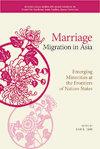This post is also available in: Japanese

Marriage Migration in Asia: Emerging Minorities at the Frontiers of Nation-States.
Sari K. Ishii, ed. February, 2016.
Description
This book reveals the status of marriage migrants as an emerging minority with multiple identity affiliations but a doubly marginalized status, both at home and in the host country.
In today’s globalized society, marriage migrations are far more diverse than the simple image of a woman migrating from a poor part of the world to a rich part. Both men and women can be marriage migrants, regardless of how wealthy or impoverished their country of origin. Today, rich and poor countries alike are sending and receiving countries for marriage migration.
Observed in the long term, the trajectories of marriage migrants often involve repeat and circular migrations. Complex and diverse trajectories are found in family dynamics and life-course events.
The essays in this volume present cases in which marriage migrants and their children have suffered due to limited access to mainstream citizenship, either in their home country or host country. These cases show that regardless of whether migrants—men, women, or their children—move from poor to rich, from rich to poor, or between similar neighboring countries, their legal, linguistic, cultural, occupational, or socioeconomic status may be degraded, especially following repeat migrations.
The more migration trajectories are repeated, the more de-territorialized marriage migrants and their children become. However, their access to full citizenship remains limited.